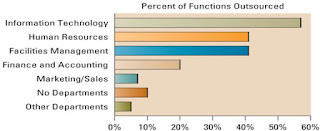MGT 300 CHAPTER7 : Storing Organizational
Information
Relational Database Fundamentals
v Information
is everywhere in an organization
v Information
is stored in databases
§ Database
– maintains information about various types of objects (inventory), events
(transactions), people (employees), and places (warehouses)
v Database
models include:
§ Hierarchical
database model – information is organized into a
tree-like structure (using parent/child relationships) in such a way that it
cannot have too many relationships
§ Network
database model – a flexible way of representing
objects and their relationships
§ Relational
database model – stores information in the form of
logically related two-dimensional tables
Entities and Attributes
v Entity
– a person, place, thing, transaction, or event about which information is
stored
§ The
rows in each table contain the entities
§ In
Figure 7.1 CUSTOMER includes Dave’s Sub Shop and Pizza Palace entities
§ Attributes
(fields, columns) – characteristics or properties of an
entity class
§ The
columns in each table contain the attributes
§ In
Figure 7.1 attributes for CUSTOMER include Customer ID, Customer Name, Contact
Name
Keys and Relationships
v Primary
keys and foreign keys identify the various entity classes (tables) in the
database
§ Primary
key – a field (or group of fields) that uniquely
identifies a given entity in a table
§ Foreign
key – a primary key of one table that appears an
attribute in another table and acts to provide a logical relationship among the
two tables
Relational Database Advantages
v Database
advantages from a business perspective include
§ Increased
flexibility
A well-designed
database should:
Handle changes quickly
and easily
Provide users with
different views
Have only one physical
view
v Physical
view – deals with the physical storage of information on
a storage device
Have multiple logical
views
v Logical
view – focuses on how
users logically access information
§ Increased
scalability and performance
A database must scale
to meet increased demand, while
maintaining acceptable performance levels
Scalability – refers to
how well a system can adapt to increased demands
Performance – measures
how quickly a system performs a certain process or transaction
§ Reduced
information redundancy
Databases reduce
information redundancy
Redundancy – the
duplication of information or storing the same information in multiple places
Inconsistency is one of
the primary problems with redundant information
§ Increased
information integrity (quality)
v Information
integrity – measures the quality of information
v Integrity
constraint – rules that help ensure the quality of
information
Relational integrity
constraint
Business-critical
integrity constraint
§ Increased
information security
v Information
is an organizational asset and must be protected
v Databases
offer several security features including:
Password
– provides authentication of the user
Access
level – determines who has access to the different types of information
Access
control – determines types of user access, such as read-only access
Database Management Systems
v Database
management systems (DBMS) – software through which
users and application programs interact with a database
DATA-DRIVEN WEB SITES
v
Data-driven Web sites – an interactive Web site
kept constantly updated and relevant to the needs of its customers through the
use of a database
Data-Driven Web Site Business Advantages
v Development
v Content
Management
v Future
Expandability
v Minimizing
Human Error
v Cutting
Production and Update Costs
v More
Efficient
v Improved
Stability
Data-Driven Business Intelligence
Integrating Information among Multiple
Databases
v Integration
– allows separate systems to communicate directly with each other
§ Forward
integration – takes information entered into a
given system and sends it automatically to all downstream systems and processes
§ Backward
integration – takes information entered into a
given system and sends it automatically to all upstream systems and processes
v Forward
integration
v Backward
integration
v Building
a central repository specifically for integrated information


Comments
Post a Comment